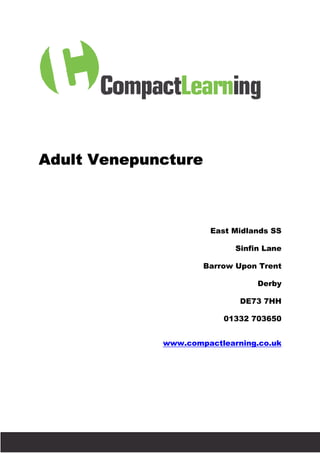
Adult venepuncture ad
- 1. Adult Venepuncture East Midlands SS Sinfin Lane Barrow Upon Trent Derby DE73 7HH 01332 703650 www.compactlearning.co.uk Brought to you by Trust Interventio tions
- 2. Venepuncture is the procedure of inserting a needle into a vein, usually to obtain blood In order to do this safely the student must: 1. Know the relevant anatomy and physiology 2. Understand the criteria for selection of an appropriate vein and device 3. Appreciate potential problems that may occur 4. Have an awareness of associated Health and Safety/ risks involved in undertaking the procedure and correct disposal of equipment Indications • To obtain blood for diagnostic purposes • To establish/ monitor levels of blood components • To establish/ monitor levels of drugs • To monitor response to medical treatments (e.g. fluids) • To provide a sample to cross match prior to transfusion • To screen for infection Brought to you by Trust Interventions
- 3. Vein construction: 3 Layers Tunica adventitia Connective tissue Surrounds, supports Tunica media Muscular tissue Contracts and relaxes Tunica intima Smooth endothelial cells Valves Brought to you by Trust Interventions
- 4. Selecting a site Usually those found in the antecubital fossa 1. Median cubital vein 2. Cephalic vein 3. Basilic vein Metacarpal veins should only be utilised for venepuncture when the other veins are not accessible Brought to you by Trust Interventions
- 5. Choosing a vein • Accessible • Unused • Easily detected • Appears healthy and patent The most prominent vein is not necessarily the most suitable vein -Visual inspection -Palpation Visually scrutinise the veins in both arms, avoiding: • Evidence of infection, bruising and phlebitis • An oedematous limb where there is status of lymph • Areas of previous venepuncture. Repeated trauma causes pain Palpate veins too: • Distinguish vein from arteries and tendons • Identify deeper veins and presence of valves • Use index finger, or fore finger, not thumb Healthy veins are soft, bouncy and refill when depressed Other factors influencing vein selection ? Injury, disease or treatment ? Position of patient ? Age of patient ? Weight of the patient ? Dehydration or Shock ? Medication/ condition that causes excessive bleeding or delayed clotting (anticoagulants, steroids, thrombocytopenia)? Fear Brought to you by Trust Interventions
- 6. Hazards and Risks • Infection- adherence to an aseptic technique (thorough hand washing and use of alcohol gel) required. Performed with single use equipment, non- sterile gloves may be worn. • Accidental damage- inadvertently punctured nerve, tendon or artery. Spend time undertaking visual inspection and palpation. • Haematoma- Caused by poor technique, failure to remove the tourniquet before removing the needle and inadequate pressure on the site. Patient/ Client must not flex arm on completion of the procedure. Identify those with relevant medical history/ drug therapy. Associated Risks • Incorrect or lack of details on request form and/or sample- Increases likelihood of errors occurring. Sample will be rejected by lab, necessitating repetition of the procedure. Always check details with patient, request form and sample correspond. • Insufficient sample/ wrong specimen bottle- necessitating repetition. • Needlestick injury- correct use of Vacutainer system and Sharps policy help reduce this. • Infected/ ‘High risk’ samples- correctly identified as such through labelling so all those involved with handling are aware. Brought to you by Trust Interventions
- 7. Equipment list….. Sharps bin Procedure tray Non-sterile gloves Apron Vacutainer device/ needle Tourniquet Alcohol hand gel Patient identification labels Specimen request Specimen bottle Gauze/ swab Procedure • Correctly identifies patient/ gains consent • Hand washing/ use of alcohol gel • Supports chosen limb • Applies Tourniquet • Selects appropriate vein Brought to you by Trust Interventions
- 8. Technique • Anchor vein • Verbally warn patient • Insert needle smoothly at angle of 15-30 degrees with bevel upwards • Level off needle and advance approx 1mm • Push specimen bottle into heamguard • Allow vacutainer to fill specimen bottle • Gently but firmly remove bottle • Remove tourniquet • Cover puncture site with gauze, remove needle, dispose of needle into sharps bin • Apply pressure to straight arm, apply plaster • Correctly label sample References and further reading Nottingham City Hospital/ queens Medical Centre/ Rushcliffe PCT Nursing Practice Guidelines (2004) Venepuncture using the Vacutainer System (*Accessible on Hospital intranet- contains extensive further reading list) Nottingham City Hospital/ Queens Medical Centre Nottingham ‘Working in New Ways’ (2004) Venepuncture and Cannulation: An educational Self-directed Package for Registered Nurses, Midwives and Non- registered staff. Johnson and Johnson (1997) Practical Guide to Peripheral Cannulation R.Seeley, T Stephens, P.Tate (1988) Anatomy and Physiology Brought to you by Trust Interventions
